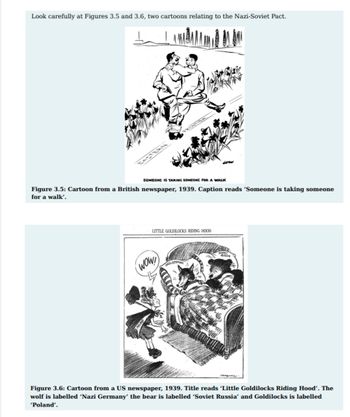Question
Please answer the last 2 history questions

Transcribed Image Text:Look carefully at Figures 3.5 and 3.6, two cartoons relating to the Nazi-Soviet Pact. (attached below)
• Figure 3.5: Cartoon from a British newspaper, 1939. Caption reads 'Someone is taking
someone for a walk'
• Figure 3.6: Cartoon from a US newspaper, 1939. Title reads 'Little Goldilocks Riding
Hood'. The wolf is labelled 'Nazi Germany' the bear is labelled 'Soviet Russia' and
Goldilocks is labelled 'Poland'
Answer the following questions in full paragraph format:
1. What does Figure 3.5 suggest about the Nazi-Soviet Pact?
2. What does Figure 3.6 suggest about the Nazi-Soviet Pact?
3. What methods do the cartoonists use to put across their message?
4. Which cartoon do you feel is more effective and why?
5. Compare and contrast the usefulness of the two cartoons for historians studying the
Nazi-Soviet Pact. Ensure that your answer considers when the cartoons were published;
the motives of the cartoonists; the audiences the cartoons were addressing; what the
cartoons suggest about the Nazi-Soviet Pact; the methods used by the cartoonists to put
across their ideas; how the cartoons compare with our own knowledge of the Nazi-
Soviet Pact. (this answer should be a minimum of 3 to 4 full paragraphs)

Transcribed Image Text:Look carefully at Figures 3.5 and 3.6, two cartoons relating to the Nazi-Soviet Pact.
I
EASTERN
SOMEONE IS TAKING SOMEONE FOR A WALK
Figure 3.5: Cartoon from a British newspaper, 1939. Caption reads 'Someone is taking someone
for a walk'.
LITTLE GOLDILOCKS RIDING HOOD
(WOW!)
NAIL GERMANT
IADH
Figure 3.6: Cartoon from a US newspaper, 1939. Title reads 'Little Goldilocks Riding Hood'. The
wolf is labelled 'Nazi Germany' the bear is labelled 'Soviet Russia' and Goldilocks is labelled
'Poland'.
Expert Solution
arrow_forward
Step 1
Introduction:
The Nazi-Soviet Pact was a political agreement between Nazi Germany and the Soviet Union signed in 1939. The pact was seen as surprising and controversial at the time, and has since been widely studied by historians. In this context, Figures 3.5 and 3.6 are two cartoons that were created in response to the pact, and they provide valuable insights into public perception and understanding of the pact.
Trending nowThis is a popular solution!
Step by stepSolved in 6 steps
